Au cours d’une discussion avec Guy Lerat Jr qui me partageait ses aventures d’accompagnement, j’apprends qu’il va devoir organiser un Team Building important pour une de ses équipes. En effet, avec les différents mouvements d’entrée / sortie, la période du confinement et la difficulté à débloquer du budget pour ce genre d’activité, recréer du lien devenait primordial. Il n’a donc pas hésité longtemps lorsque l’occasion s’est présentée !
Après quelques échanges d’idée, je lui ai finalement proposé de l’aider à construire cet atelier et de le co-animer ensemble, ce qu’il a gentiment accepté !
Voici en détails ce que nous avons proposé et ce qui s’est réellement passé ! 😉
Contexte
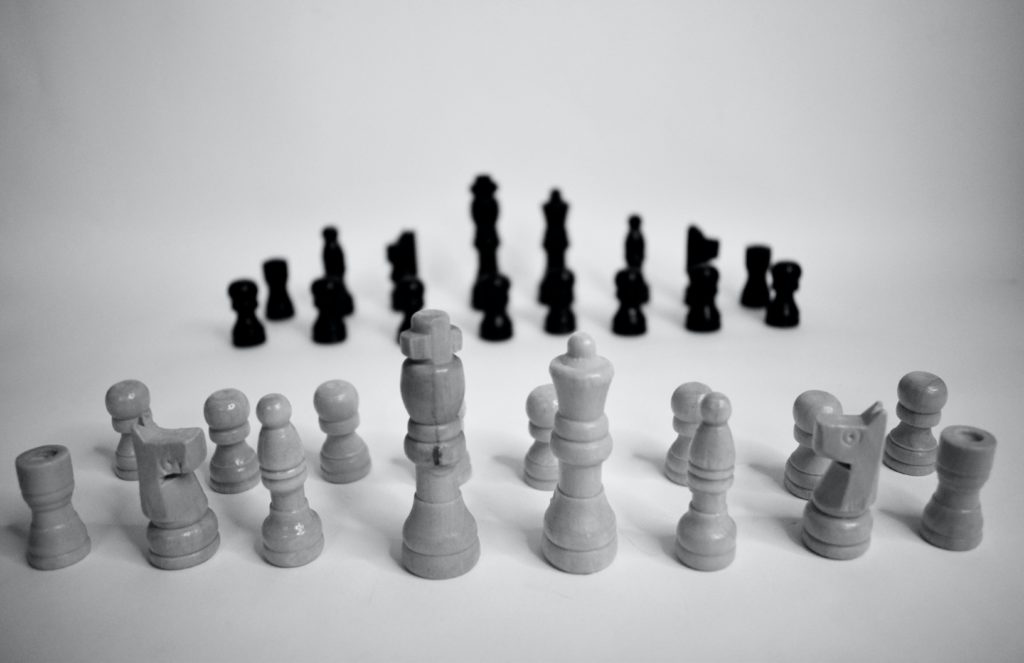
Voici les informations avec lesquelles je pars pour débuter ma réflexion :
- Nombre de personnes : 11
- Durée : 3h
- Format : Présentiel
- Intention : Recréer du lien entre les membres de l’équipe et assainir certaines relations conflictuelles.
J’ai donc besoin d’un peu plus d’éléments concernant ce dernier point. En effet, l’important pour moi est d’avoir une idée des tensions existantes pour éviter de créer l’étincelle qui embraserait le tout pour au contraire construire la relation.
Note : Je ne cherche pas à éviter le problème mais plutôt à mettre le terreau propice à son expression et à sa résolution. C’est ce que je mets derrière la notion de prévention des conflits que je préfère à la notion de gestion de conflits, mais cela reste une question d’interprétation 🙂
Ce que je comprends rapidement est qu’un nouveau Product Owner est arrivé, qu’il est mis sous pression et qu’il la retransmets à l’équipe sous différentes formes. Il n’a pas encore réussi à trouver sa place et il passe après une personne plutôt charismatique et appréciée de l’équipe.
Pour le reste, l’équipe est composée de profils variés (tech / non tech), provenant de sociétés différentes.
Voyons voir ce que l’on peut faire à partir de là ! 😉
Conception
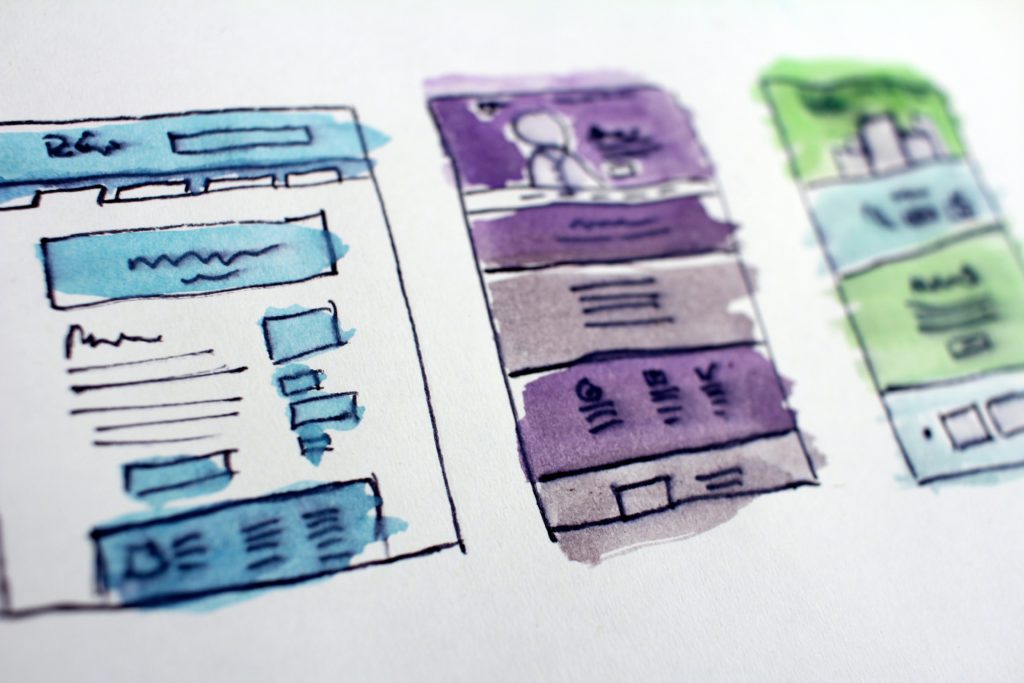
Commençons par le commencement. La contrainte de temps est de 3h, on va donc partir sur une structure de base du type : introduction, conclusion, une pause et 2 sections de travail.
Guy me partage qu’il avait eu l’occasion de faire dans le passé quelques ateliers avec eux autour de l’équipe : le Team Canvas et le Speed Boat sortent donc de notre liste pour éviter de faire doublon.
Ce qui me paraît important dans des contextes un peu tendus comme celui-ci est de redonner un aspect humain aux relations que tissent les personnes entre-elles. Je veux dire par cela que les personnes sont plus que leur fonction et leur rôle : elles viennent de quelque part, elles ont des passions, des envies et des choses qui font qu’elles sont uniques. Ce sont des êtres humains avant d’être un titre de poste ! 🙂
Allez, restons simples, allons droit au but, concevons !
Personal Map

Je propose donc de commencer par un atelier Personal Map, proposé par le Management 3.0 et inspiré des cartes heuristiques ou Mind Map. J’apprécie tout particulièrement cet exercice car il est simple et visuel. On peut facilement mettre en mouvement les personnes et créer des conversations : c’est donc une bonne activité pour briser la glace !
On ouvre ainsi le bal en demandant aux gens de partager une vision plus personnelle de qui ils sont. Cela a tendance à créer de la surprise et de la curiosité chez les autres. On va donc partir de soi mais notre attention va aller vers la découverte de l’autre.
Ainsi, en terme d’animation, on pourra opter pour plusieurs choses :
- (10′) Un premier temps individuel de construction de sa Personal Map
- (15′) Un second temps de partage :
- en mode Galerie où l’on affiche toutes les Personal Maps au mur et où les échanges informels se créent,
- ou en mode Binôme pour des échanges plus intimistes quitte à itérer à plusieurs reprises.
Objectifs, Freins, Risques

Depuis la formation suivie avec Christopher Avery autour de la construction d’équipes performantes (que je proposerais peut-être un jour en français), je garde toujours en tête la notion de « tâche commune » pour aligner une équipe. Que doit-on faire ensemble ? À quoi contribuons nous tous et qui nous dépasse ?
J’ai également tendance à dire que c’est dans la difficulté que l’on crée des liens avec les autres, c’est pourquoi je propose d’enchaîner sur un atelier autour :
- des Objectifs : pour définir cette tâche commune,
- des Freins : pour exposer les difficultés actuelles,
- et des Risques : pour mettre en conscience collective les difficultés potentielles à venir.
Note : Certains diront qu’en fait ce n’est qu’un Speed Boat adapté, et je leur dirais qu’ils ont tout à fait raison ! 😛 Plaisanteries mises à part, l’idée ici est de focaliser l’équipe vers l’avant (objectif) et de capitaliser sur l’énergie de la frustration (freins, risques) pour avancer ensemble. Le tout dans un temps plus réduit qu’un Speed Boat habituel.
Nom d'équipe
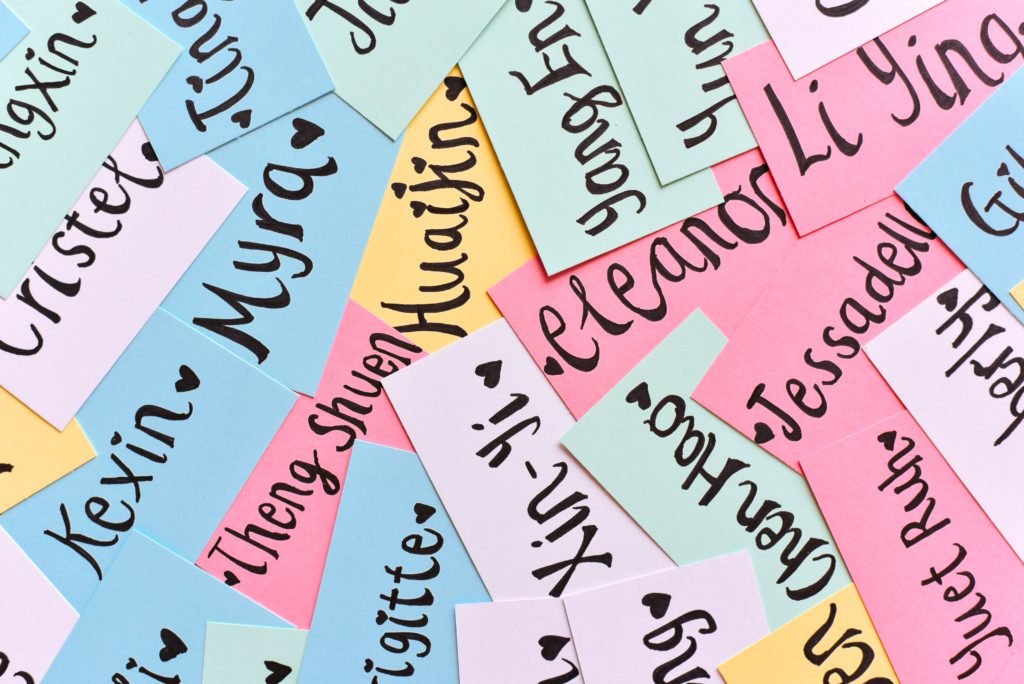
Guy me partage que de rediscuter du nom de l’équipe pourrait être une bonne idée. En effet, il a eu quelques demandes dans cette direction et cela pourrait permettre de donner un nouvel élan.
Je lui propose de prendre cette partie ce qui me permettra de prendre un peu de recul et de préparer la suite 🙂
Matrice Give and Take

Au cours de nos échanges, le sujet de la Matrice Give and Take a émergé à plusieurs reprises. En effet, cela permettrait de matérialiser de manière plus officielles des interactions entre les différents rôles de l’équipe.
Cependant, je me rends bien compte que nous n’avons pas la même manière d’appréhender l’exercice. Alors que Guy décrit la matrice autour du « ce que j’attends de toi », je la décris de mon côté plutôt autour du « ce que je peux faire pour toi ». Une nuance notable qui a bien évidemment ses avantages et ses inconvénients.
Il m’a alors proposé d’animer cette partie pour voir la différence 🙂
Note : en bref, dans le premier cas nous sommes plus dans une injonction (Obligation au sens Responsibility Process) alors que dans le second cas nous sommes plus dans un choix conscient (Responsibility au sens Responsibility Process)
Résumé et Timing

- (5′) Introduction
- (40′) Personal Map
- (45′) Objectifs, Freins, Risques
- (10′) Pause
- (10′) Nom d’équipe
- (45′) Matrice Give and Take
- (10′) Conclusion
Déroulé réél
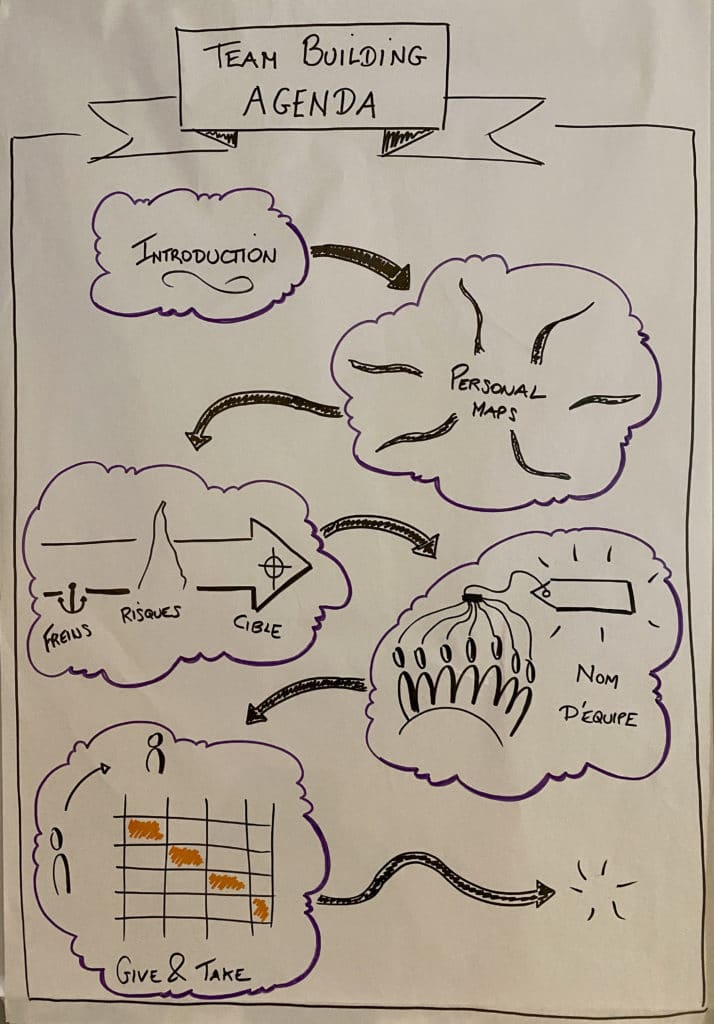
Le grand jour arrive enfin. Guy me donne rendez-vous à 9h et me précise qu’il ne serait pas étonné que nous soyons les premiers. Ah. Dès le départ, on sait alors qu’il va falloir réajuster des choses. La question qui se pose est donc la suivante : à quel point ?
9:00 : Effectivement, nous ne sommes que 4. Je profite du temps à disposition pour préparer quelques posters et faire connaissance avec les 2 personnes qui sont là.
9:30 : 2-3 personnes arrivent au compte goutte et nous apprenons que le reste du groupe est dans la même voiture. Ils comptent arriver sur les coups des 10h.
Modification d'animation
Un réajustement est donc nécessaire, nous avons déjà perdu 1/3 du temps à disposition. Je propose à Guy que nous gardions la Personal Map dans un premier temps, que nous adapterons selon la manière dont le groupe réagit.
Je vais pour ma part simplifier la séquence Objectifs, Freins, Risques pour gagner un peu de temps tout en restant focalisé sur l’intention initiale : consolider le groupe. Pour ce faire, nous ne ferons que la partie Objectifs, afin que chacun soit bien au fait de ce à quoi il contribue et qu’ils aient l’opportunité de se réaligner si besoin.
Arrivée des retardataires
10:10 : Le reste du groupe arrive enfin, et ce avec beaucoup d’énergie et d’excitation. J’observe le groupe avec attention pendant que Guy tente de rassembler tout le monde pour démarrer.
En effet, les personnes sont assez dissipées et une blague en amenant une autre, il est encore difficile de les canaliser.
Nous démarrons néanmoins avec notre première séquence.
Personal Map
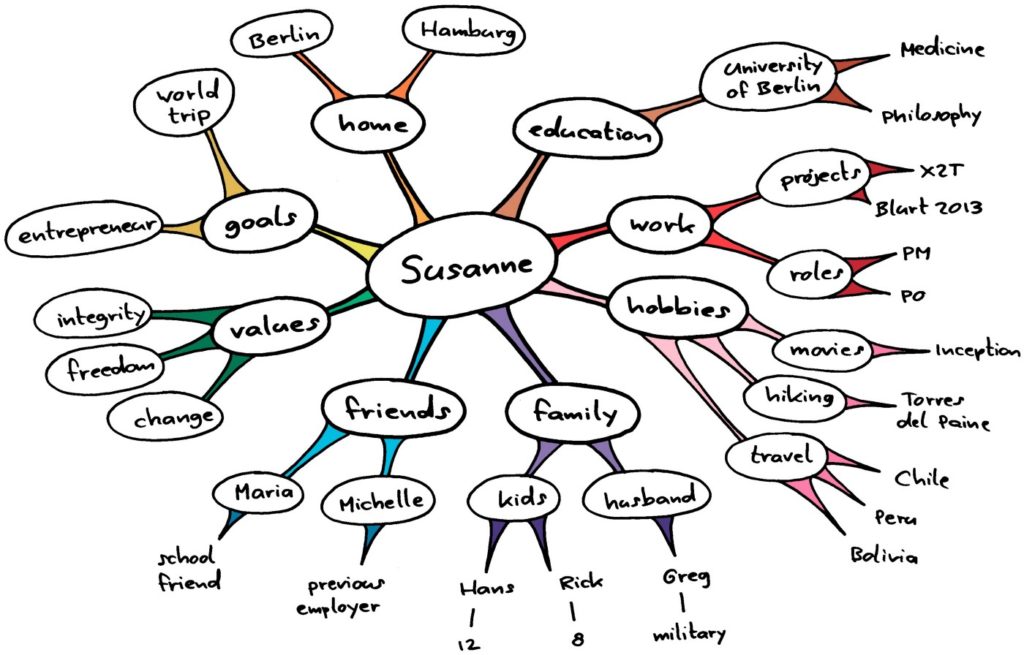
Après avoir préparé un exemple sur une feuille de Paperboard, nous expliquons le concept aux participants. Sous forme de Mindmap, nous les invitons à partager autour de différents thèmes les concernant : leurs objectifs, leurs valeurs, leur famille, leurs hobbies, leurs formations…
Des remarques émergent de certaines personnes du groupe :
on raconte notre vie quoi !
Ce à quoi il me paraît important de préciser ces 2 choses :
- L’objectif est effectivement de partager des informations qui dépassent légèrement la sphère professionnelle car au-delà de ce que vous faites, vous êtes une personne à part entière !
- Maintenant, à vous de décider du niveau d’information et de détails que vous souhaitez partager. Il n’y a pas de contraintes particulières ni d’obligations !
Note : Il me paraissait important de redonner un cadre à l’exercice pour mettre le groupe en mouvement. Et cela en restant dans l’invitation et non l’injonction malaisante.
Nous laissons alors travailler chaque personne individuellement pendant 10 minutes.
Travail en binôme
Pendant que chacun élabore sa Personal Map, nous échangeons rapidement avec Guy sur le fait que les entretiens en binôme pourraient vraiment avoir de la valeur. Nous partons donc dans cette direction pour un premier tour.
Au bout des 10 minutes, nous décidons d’enchaîner par l’entretien en binôme avec la consigne suivante :
Nous vous proposons de vous mettre en binôme, d’échanger vos Personal Maps et d’échanger pendant quelques minutes ensemble
Note : J’insiste sur le fait de bien séparer les binômes pour créer un environnement plus intimiste et donc plus propice à un partage personnel.
Facilitation
La facilitation ici est assez simple car il suffit de passer près de chaque groupe pour voir comment les échanges se déroulent :
- Y a-t-il des surprises ?
- Des points communs qui émergent ?
- Quelle est l’ambiance dans cette relation à deux ?
Trop directif ?
Nous échangeons rapidement à ce sujet car souhaitant bien faire, il se questionne sur le fait d’être directif de la sorte. Je lui indique que de mon point de vue ce n’est pas gênant si l’intention est claire et que cela est limité dans le temps.
En effet, la contrainte permet de créer l’espace d’apprentissage et d’interaction qui ne pourrait peut-être pas avoir lieu autrement.
L’idée ici est de bien garder en tête que rien n’est tout blanc ou tout noir. Ce qui importe est surtout de maximiser les bénéfices de notre choix et d’en limiter les inconvénients ! 🙂
Note : vous pouvez aller voir mon article autour du Polarity Management pour plus de détails.
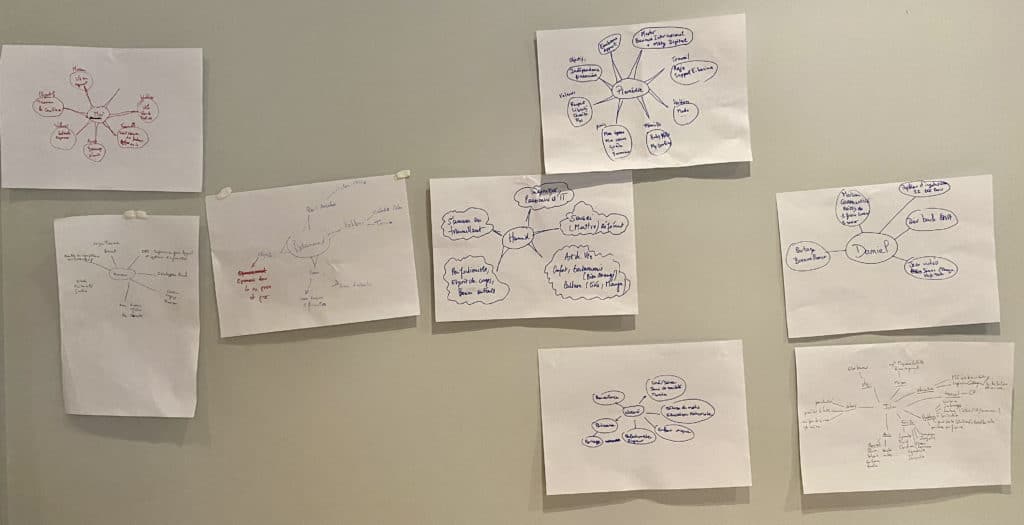
Après ces quelques entretiens à 2, nous avons proposé au groupe d’afficher leur Personal Map sur le mur en mode Galerie. Comme cela, tout le monde pourra aller compléter sa vision du groupe quand il/elle le souhaitera 🙂
Objectifs

Nous passons ensuite à la séquence autour de l’Objectif. C’est un exercice pas toujours facile et qui nécessite que chacun se positionne et regarde au loin. On peut d’ailleurs voir que le « au loin » n’est pas à la même distance pour tout le monde, ce qui est tout à fait ok 🙂
Je me permets alors d’ajouter un élément complémentaire. En plus de l’objectif d’équipe, je leur demande de réfléchir au pourquoi de cet objectif. À quoi l’atteinte de cet objectif va t-elle contribuer ?
Facilitation
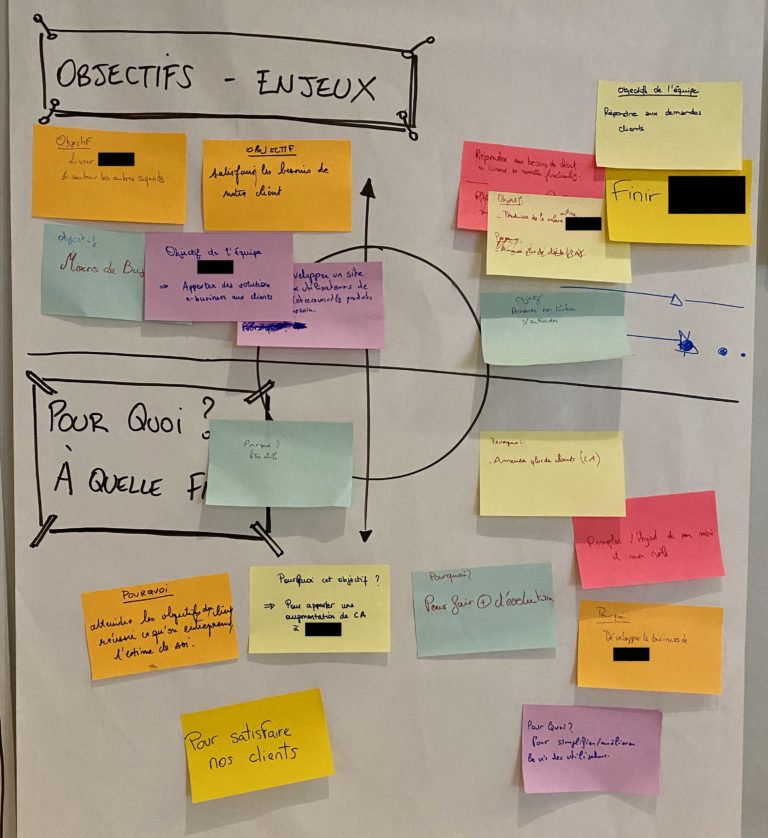
Description de l'objectif
Après quelques minutes de réflexion individuelle sur Post-it, nous passons chaque personne une par une pour la description de l’objectif. Comme prévu, nous voyons bien une grande disparité dans les réponses.
On y retrouve des objectifs de portées assez différentes.
Des plus lointaines comme :
Satisfaire les besoins de nos clients
Et des plus terre à terre comme :
Livrer tel projet
Produire moins de bugs
Assurer nos tâches
C’est cette diversité des visions que l’on cherche à matérialiser et cela permet déjà de générer quelques échanges autour de cette tâche commune à l’équipe.
Intention de l'objectif
On passe ensuite sur la 2ème partie autour de l’intention de l’objectif en lui-même.
Il y a à nouveau une certaine diversité dans les réponses mais une retient tout particulièrement mon attention :
Atteindre les objectifs du client pour réussir ce que l’on entreprend et ainsi alimenter une certaine estime de soi.
Cette réponse me paraît intéressante à 2 niveaux :
- Le contenu de la réponse montre un certain recul et une quête qui dépasse la simple exécution d’un travail
- La personne qui l’a exprimé avait tendance à se comporter un peu comme un bout en train depuis le début. Son énergie a alors changé à partir d’ici, elle est devenue plus présente et plus focalisée.
Note : J’ai tendance à croire que le fait de déposer le sujet du « pour quoi » permet à chacun de redonner une perspective à son travail, autant individuel que collectif. Cela permet au groupe de se construire au travers de la diversité des visions et de créer cette conscience commune du positionnement de chacun, sans jugement.
Après quelques échanges, nous enchaînons sur la suite car notre temps reste limité !
Nom d'équipe
Le nom d’une équipe contribue à bâtir son identité. L’équipe ayant vu des personnes rentrer et sortir ces derniers mois, la question de savoir si leur nom leur convenait toujours avait du sens.
Guy se charge alors de cette séquence :
- Il propose à chaque personne d’inscrire sur des post-it jusqu’à 3 noms d’équipe
- On réunit toutes les idées sur Paperboard
- On vote pour en faire ressortir un top 3
- Puis il propose un des noms restants qu’il soumet à objections
Note : J’ai proposé ici d’utiliser le consentement (personne n’est contre) plutôt que le consensus (tout le monde est pour) pour gagner un peu de temps
D’une manière assez étonnante et ce malgré une demande de certaines personnes, le choix du groupe s’est porté sur le nom actuel de l’équipe.
Cela aura au moins eu le mérite d’avoir été un choix collectif ce coup-ci ! 🙂
On enchaîne donc rapidement sur la séquence suivante : la matrice Give and Take.
Matrice Give and Take
J’ai découvert la matrice Give and Take dans l’ouvrage Gamestorming. J’apprécie tout particulièrement cet exercice car c’est un excellent support de conversation.
En effet, il permet de construire le cadre de relation entre différentes parties sur la base d’un échange mutuel. Dans mon cas, j’oriente les échanges sur les besoins et comment chacun peut y répondre.
Phase 0 : Initialisation
Je construis donc rapidement la matrice avec les différents rôles représentés dans le groupe :

On a donc ici 4 rôles : Product Owner (PO), Scrum Master (SM), Fonctionnel (FCT) et Développeur (DEV). Je les dispose comme ci-dessus, en vertical et en horizontal, dans le même ordre. La flèche indique le sens de lecture : le rôle en vertical « donne » au rôle en horizontal.
Phase 1 : Besoins
Dans cette phase, je vais demander à chaque rôle de venir remplir « sa » case.
Cette dernière correspond à ce que le rôle se donne à lui-même. On a traduit cela comme étant ses besoins pour pouvoir remplir sa mission du mieux possible.
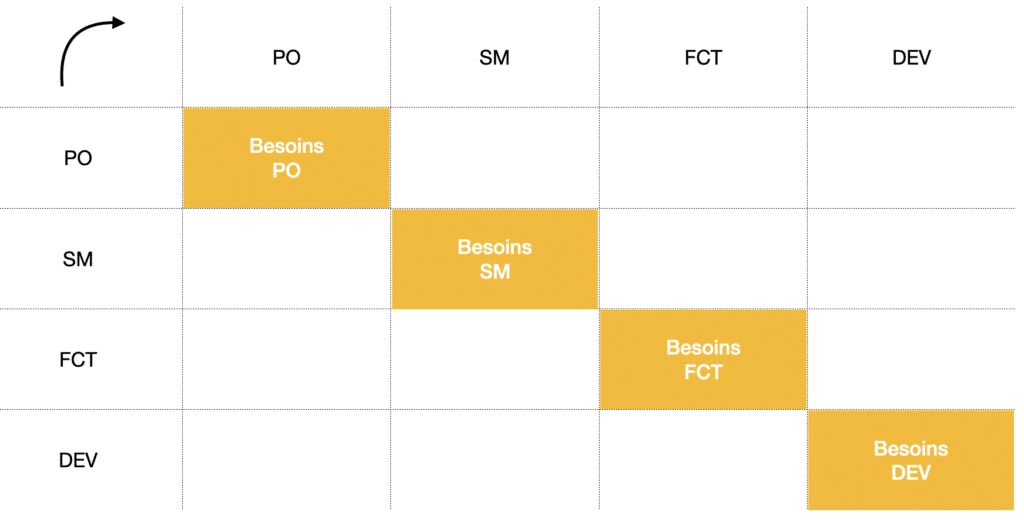
Nous parlons ici bien de besoins correspondant aux rôles et pas aux personnes. Ainsi, les rôles représentés par plusieurs personnes doivent être l’expression du collectif associé.
Ce fut le cas des FCT et des DEV qui ont dû travailler chacun dans un groupe pour définir leurs besoins.
Facilitation
Après quelques minutes de réflexion, je demande à chaque rôle de venir déposer son post-it dans sa case en expliquant au reste du groupe chaque élément qui y est inscrit.
Note : j’accepte ici de déroger à la règle du « une idée, un post-it » par souci de place sur la matrice. Nous allons cependant pouvoir utiliser cela à notre avantage par la suite 😉
Le travail de facilitation est ici principalement dans la distribution de la parole. Je m’assure simplement de la bonne compréhension de chaque besoin par le reste du groupe par du questionnement ou de la reformulation.
Du conflit à l'empathie
Un élément notable arrive dans l’interaction du groupe lors de la présentation des besoins du PO. En effet, après son intervention, le PO est interpellé par les DEV qui considèrent qu’il manque des éléments et donc qu’il a d’autres besoins à satisfaire !
Alors que ces personnes avaient tendance à être en opposition habituellement, on les voit alors en co-construction et en empathie les uns envers les autres. La sauce semble prendre et cela est encourageant !
L’énergie du groupe est plus canalisée qu’au début et on sent que chacun est focalisé sur l’écoute de l’autre.
Phase 2 : Remplissage
Lorsque tous les rôles sont passés, j’invite chaque personne à venir voir comment ils peuvent contribuer à satisfaire leurs besoins. Je propose la plupart du temps aux gens de se lever et de se rapprocher du tableau, ce qui a tendance à générer les premières discussions.
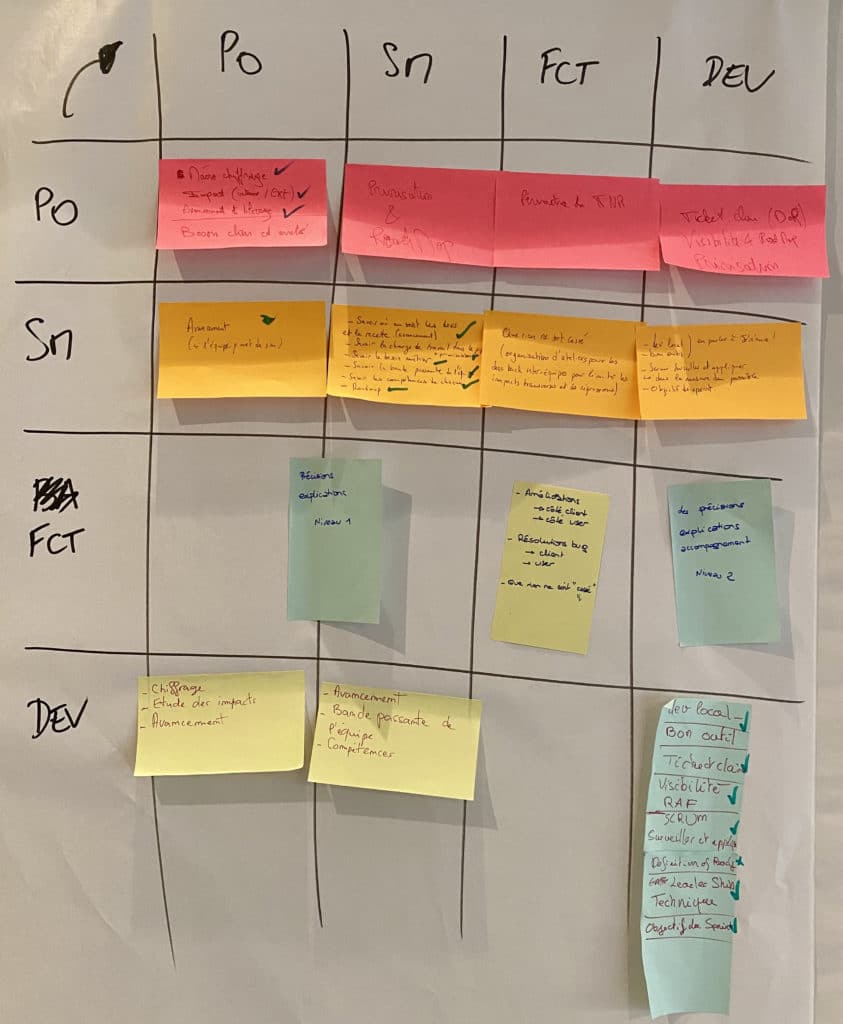
Après une quinzaine de minutes, on voit que la matrice s’est bien remplie. Je propose alors un dernier passage pour voir si l’ensemble des besoins ont été satisfaits ou non.
Chaque rôle revient alors à son tour et coche les besoins satisfaits sur son post-it. C’est là l’intérêt d’avoir tout concentré sur un même post-it, on a directement la synthèse que l’on recherche 🙂
Le fait que tous les besoins ne soient pas satisfaits n’est pas forcément un problème. En effet, cela permet au groupe d’avoir les conversations suivantes :
- Avons-nous ici les bonnes personnes pour satisfaire ce besoin ?
- Est-ce que des précisions sont nécessaires ?
- Comment pouvons-nous collectivement répondre à ce besoin ?
Nous voyons à nouveau la puissance de l’exercice comme support de conversation. Les échanges viennent naturellement, les discussions sont un mélange de curiosité et de recherche de solutions.
Ainsi, on redonne un peu de structure aux interactions entre les rôles ainsi qu’une vision d’ensemble qui pourra être réutilisée à l’avenir.
En effet, c’est un travail évolutif qui pourra être un support pour une future rétrospective 😉
Conclusion

L’animation de ce workshop fut plein de rebondissements ! Il a fallu réajuster le contenu en temps réél en prenant en compte les apprentissages du groupe au fur et à mesure.
Nous avons atteint les objectifs de ce moment collectif : consolider les liens entre les personnes et les mettre dans une démarche de co-construction. Les personnes en tension se sont même trouvés des points communs 🙂
La matrice Give and Take est un outil extrêmement puissant pour avoir des conversations structurantes entre rôles. Elle donne un aspect plus chaleureux à l’exercice tant apprécié des organisations « des rôles et responsabilités« , en remettant l’humain et ses besoins au centre.
Merci à Guy de m’avoir fait confiance et de m’avoir laissé co-animer avec lui 🙂







2 réponses
top ! merci bcp pour le partage !
Encore une fois merci ! merci ! merci !
Quand j’ai besoin de clarté et de quelque chose de complet entre théorie des outils, applications concrètes et REX, je sais où aller.
J’aime beaucoup la structure de tes articles, c’est vraiment aidant.